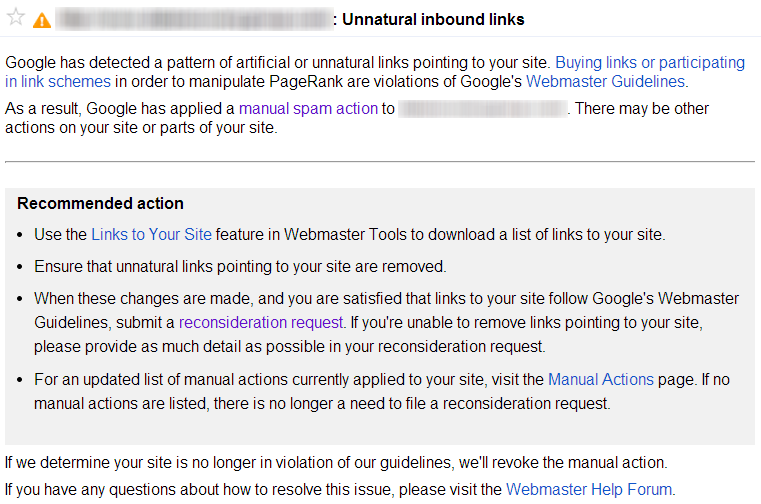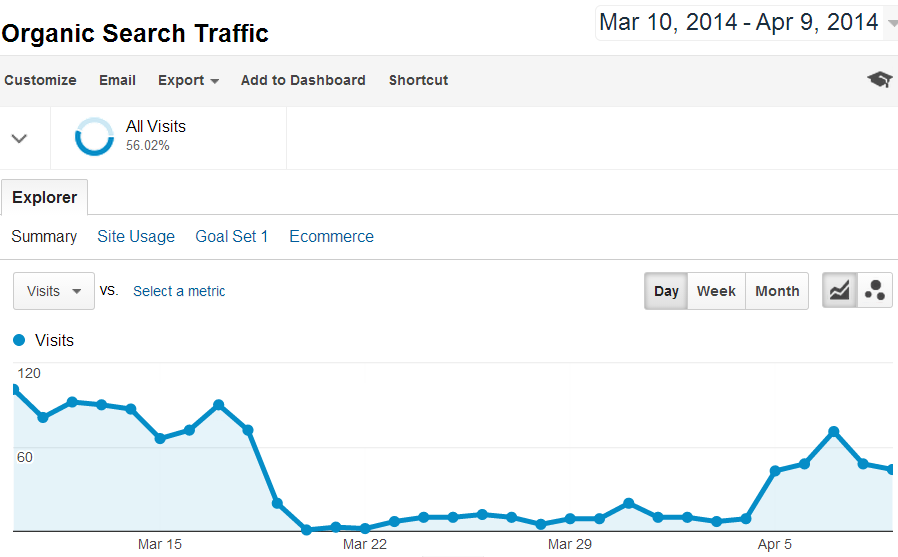Has anyone else out there felt the wrath of Google’s manual penalties over the past few weeks? I most certainly have. On March 20th, the same day that the SEO community exploded with news of My Blog Guest receiving a manual site-wide action penalty from Google, I received a similar unfortunate message in Google Webmaster Tools:
Anyone who’s dealt with or currently dealing with a manual action-site-wide penalty from Google knows the crippling impact that this has on a website. A site-wide action, like the one we received, means that you don’t show up in Google for anything – not even your brand name. We’ve had this particular client for quite some time, (who’s identity will remain anonymous) and they have done dabbling in link building before we worked with them. We knew they had some bad links in their profile, which we attempted to clean up or disavow after the Penguin update hit Memorial day weekend of 2013. While we received our penalty on the same day that My Blog Guest got hit, we can’t say that there’s a direct connection. We did engage in guest blogging through My Blog Guest, but not at an abnormal level, and they were never a My Blog Guest publisher. Other link building activities of years past was likely what resulted in the penalty, but as other examples show how much of a statement Google is trying to make about guest blogging, I wouldn’t rule it out as the spark to the fire yet.
After 12 days of visiting ancient websites, emailing outdated email addresses, and a whole lot of self induced stress, we submitted our reconsideration request to Google. Expecting that it “might take a while” to hear back from them, I was surprised that organic traffic started showing up in Google Analytics four days after submitting the request, and that we received this message only 18 days after the manual spam action was implemented:
Okay, so we’re not out of the woods yet, and the site currently has a “partial match unnatural links penalty”, but we were thrilled by this news because,
A. We now show up in Google SERPs for branded keywords.
B. Many of our target keyword rankings are back to where they were before, and organic traffic is close to where it was before.
C. With a few exceptions, I had previously read cases where it took 3-4 reconsideration requests and 2-3 months for a site to show back up in Google.
My Five Biggest Tips for Dealing with a Manual Spam Action Penalty
I don’t know how unusual this turnaround is for getting a site’s manual spam action lifted, and I’m sure that much of it depends on the quantity and quality of links, but I’m assuming our case for the most part was a success story. I also thought that explaining what we did might shed some much needed light on a confusing subject.
1. Set Up Your Spreadsheet Correctly
If you’re ever going to have a chance to get your site’s manual spam action revoked, you’re going to have to show Google that you’re doing everything in your power to cleanup your backlink profile, and you have to do that through a Google Drive Spreadsheet. First things first, make sure you change the privacy sharing settings of your spreadsheet! Otherwise no one at Google can’t even view it. Add all of your root domain’s site’s backlinks (good and bad) to the spreadsheet, and be sure you establish columns for anchor text and whether or not the link has a nofollow attribute. Following a column setup like this helps document all the fun work you’ll be doing:

Google needs to know that you put as much TLC into cleaning up your backlinks as possible, and that you didn’t just identify your bad links and then throw them into their disavow links tool. You should make columns for 1st AND 2nd contact dates, contact information you collect, the end status of a link, and a column for why you would be forced to disavow a page or site. Regardless of the reason, it’s better to provide information about why you’re resorting to disavowing than to leave them wondering.
2. Machete – Not a Fine Tooth Comb
When responding to a question from Dan Barker, Matt Cutts stated that too many webmasters clean up their links with a fine tooth comb instead of a machete. He recommended that webmasters use the “domain:” feature when disavowing links. Translation: in your disavow links file, you should list domain:spammysite.com instead of twenty individual spammysite.com pages that you have a link on. I thought that was actually a pretty good tip from Matt, as disavowing a single page on a site only works for as long as your link stays on that page. Any redirects or site changes would likely be seen as a new link created by a Google bot, and disavowing the entire site protects your website from being penalized by Google yet again. Also, backlink information can be missed by tools like Majestic, Open Site Explorer, Ahrefs, and especially Webmaster Tools. I’m not saying that you need to disavow the domain for every bad link you encounter, but you should have a reason as to why it would be beneficial to have a link on a different page of the site.
3. If You Wouldn’t Create The Link Today – It’s Bad
While parsing through thousands of backlinks, we ran across plenty of links that we labeled as “maybes”. An example would be links that were created naturally, but used bad anchor text, or were on an off topic page. When you’re in that type of situation, it’s better to be safe and sorry and stick to the machete wielding mindset. When using quick judgement on a link, I followed the rule that if I wouldn’t put the effort into creating the link today, then it’s bad. Even if Google would overlook the link today, they might hate it tomorrow, and it would likely hold little to no value in the future.
4. Make the Reconsideration Request Sincere
Regardless of what you really think, there’s no point in denying to Google that your site deserved to be penalized. Share your Google spreadsheet, (double check that they have the ability to view it) and outline the countless hours you invested in cleaning up your backlink profile, and the specific types of links you aimed to remove. In addition, we stated that we asked links to be removed that were clearly set up to pass Pagerank, or if they had no benefit to their website’s users, i.e. tips #2 and #3.
Most importantly, you should be able to outline what online marketing strategies you have been engaging in, or plan to accomplish in the future that shows Google that your goal is to create a better user experience for your website visitors. We shared articles that we created on the blog of high quality and are useful for our site users.
5. Read Up
You’re certainly not the only site that’s gone through this painful process. If anything, reading about strategies that have worked for others can give your moral a much needed boost. Here are a few resources that I relied on:
- My favorite: Google Unnatural Links Manual Penalty: A Recovery Guide
- Ultimate Guide to Google Penalty Removal – Moz
- Recovering from a Partial Match Unnatural Links Penalty
- Volusion.com Case Study – A good checklist for evaluating links.
Because we’re still dealing with the partial match links penalty, we’re not finished with this post quite yet. Most likely we’ll need to take a closer look at links that we think are good, be sure that there aren’t any bad anchor text links that haven’t been disavowed yet, and try even harder to remove bad links – even if we already disavowed them.
You Can’t Bribe Google, But You Can Pay Them
While you are working on getting your penalty lifted, you still have to deal with the lack of website traffic during that period. If you find that it’s necessary to regain some lost branded traffic, you can start bidding on your own brand name through Google Adwords – if you aren’t already doing so. Be sure that you use only exact match keywords and that you’re taking advantage of sitelinks in Adwords.
While this whole process has been quite frustrating for me and everyone involved, it’s been more of a wake up call than anything else. You can bet your bottom dollar that Google will continue cracking down on-sites with bad link profiles in the near future. Even if Google hasn’t hit your site with algorithm or manual actions, you should be taking the time to make sure your site’s backlink profile is clean now more than ever.
Best of luck with making everlasting peace with Google!




Leave a Reply